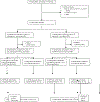Safety and pharmacokinetics of oral and long-acting injectable cabotegravir or long-acting injectable rilpivirine in virologically suppressed adolescents with HIV (IMPAACT 2017/MOCHA): a phase 1/2, multicentre, open-label, non-comparative, dose-finding study
- PMID: 38538160
- PMCID: PMC11213970
- DOI: 10.1016/S2352-3018(23)00300-4
Safety and pharmacokinetics of oral and long-acting injectable cabotegravir or long-acting injectable rilpivirine in virologically suppressed adolescents with HIV (IMPAACT 2017/MOCHA): a phase 1/2, multicentre, open-label, non-comparative, dose-finding study
Abstract
Background: Combined intramuscular long-acting cabotegravir and long-acting rilpivirine constitute the first long-acting combination antiretroviral therapy (ART) regimen approved for adults with HIV. The goal of the IMPAACT 2017 study (MOCHA [More Options for Children and Adolescents]) was to assess the safety and pharmacokinetics of these drugs in adolescents.
Methods: In this phase 1/2, multicentre, open-label, non-comparative, dose-finding study, virologically suppressed adolescents (aged 12-17 years; weight ≥35 kg; BMI ≤31·5 kg/m2) with HIV-1 on daily oral ART were enrolled at 15 centres in four countries (Botswana, South Africa, Thailand, and the USA). After 4-6 weeks of oral cabotegravir (cohort 1C) or rilpivirine (cohort 1R), participants received intramuscular long-acting cabotegravir or long-acting rilpivirine every 4 weeks or 8 weeks per the adult dosing regimens, while continuing pre-study ART. The primary outcomes were assessments of safety measures, including all adverse events, until week 4 for oral cabotegravir and until week 16 for long-acting cabotegravir and long-acting rilpivirine, and pharmacokinetic measures, including the area under the plasma concentration versus time curve during the dosing interval (AUC0-tau) and drug concentrations, at week 2 for oral dosing of cabotegravir and at week 16 for intramuscular dosing of cabotegravir and rilpivirine. Enrolment into cohort 1C or cohort 1R was based on the participant's pre-study ART, meaning that masking was not done. For pharmacokinetic analyses, blood samples were drawn at weeks 2-4 after oral dosing and weeks 4-16 after intramuscular dosing. Safety outcome measures were summarised using frequencies, percentages, and exact 95% CIs; pharmacokinetic parameters were summarised using descriptive statistics. This trial is registered at ClinicalTrials.gov, NCT03497676, and is closed to enrolment.
Findings: Between March 19, 2019, and Nov 25, 2021, 55 participants were enrolled: 30 in cohort 1C and 25 in cohort 1R. At week 16, 28 (97%, 95% CI 82-100) of the 29 dose-evaluable participants in cohort 1C and 21 (91%; 72-99) of the 23 dose-evaluable participants in cohort 1R had reported at least one adverse event, with the most common being injection-site pain (nine [31%] in cohort 1C; nine [39%] in cohort 1R; none were severe). One (4%, 95% CI 0-22) participant in cohort 1R had an adverse event of grade 3 or higher, leading to treatment discontinuation, which was defined as acute rilpivirine-related allergic reaction (self-limiting generalised urticaria) after the first oral dose. No deaths or life-threatening events occurred. In cohort 1C, the week 2 median cabotegravir AUC0-tau was 148·5 (range 37·2-433·1) μg·h/mL. The week 16 median concentrations for the every-4-weeks and every-8-weeks dosing was 3·11 μg/mL (range 1·22-6·19) and 1·15 μg/mL (<0·025-5·29) for cabotegravir and 52·9 ng/mL (31·9-148·0) and 39·1 ng/mL (27·2-81·3) for rilpivirine, respectively. These concentrations were similar to those in adults.
Interpretation: Study data support using long-acting cabotegravir or long-acting rilpivirine, given every 4 weeks or 8 weeks, per the adult dosing regimens, in virologically suppressed adolescents aged 12 years and older and weighing at least 35 kg.
Funding: The National Institutes of Health and ViiV Healthcare.
Copyright © 2024 Elsevier Ltd. All rights reserved.
Conflict of interest statement
Declaration of interests BMB, KB, PS, AHG, MAM, KC, and PO received IMPAACT Network grant funding from the National Institutes of Health (NIH) to support work on this protocol. AHG and PO's institutions have Clinical Trials Agreements (CTAs) with ViiV Healthcare to support the IMPAACT 2017 study. AHG's institution has a CTA with Janssen to support COVID-19 research and AHG is part of the ViiV Healthcare Pediatric Advisory Board. BMB, KB, MAM, SW, and RM's institution receives funding from ViiV Healthcare. MAM is a consultant for Bio-rad and receives royalties from Elsevier; their institution receives funding from Gilead for industry-sponsored research and funding from the NIH for HIV prevention and microbicide-related research. BMB's institution receives grant funding from Janssen for the study. HC, RMVS-R, and KV are employees of Janssen and have stock and stock options with Johnson & Johnson. ALA received grants or contracts from Gilead, Merck, and ViiV; and is content development faculty for the Simply Speaking HIV Prevention Series, an expert witness, an unpaid Advocates for Youth Board Chair, and an unpaid HIVMA Vice Chair. AC-G is a ViiV Healthcare consultant. CM and CMH are employees at ViiV Healthcare. SLF and JH are employees at GSK. SLF and CM own GSK stock or stock options. EVC is a Data Safety and Management Board member for a paediatric antibacterial study with Melinta Pharmaceuticals. All other authors declare no competing interests.
Figures








References
-
- Daltro ACB, Almeida CS, Unfried AGC, de Aquino TR, Travassos AGA. Virological failure and adherence to antiretroviral therapy in adolescents and young adults living with human immunodeficiency virus. Trop Med Int Health 2023; 28(3): 162–74. - PubMed
-
- Guidelines on Long-Acting Injectable Cabotegravir for HIV Prevention [Internet]. Geneva: World Health Organization; 2022. (Accessed 16 August 2023). - PubMed
-
- Orkin C, Bernal Morell E, Tan DHS, et al. Initiation of long-acting cabotegravir plus rilpivirine as direct-to-injection or with an oral lead-in in adults with HIV-1 infection: week 124 results of the open-label phase 3 FLAIR study. Lancet HIV 2021; 8(11): e668–e78. - PubMed

